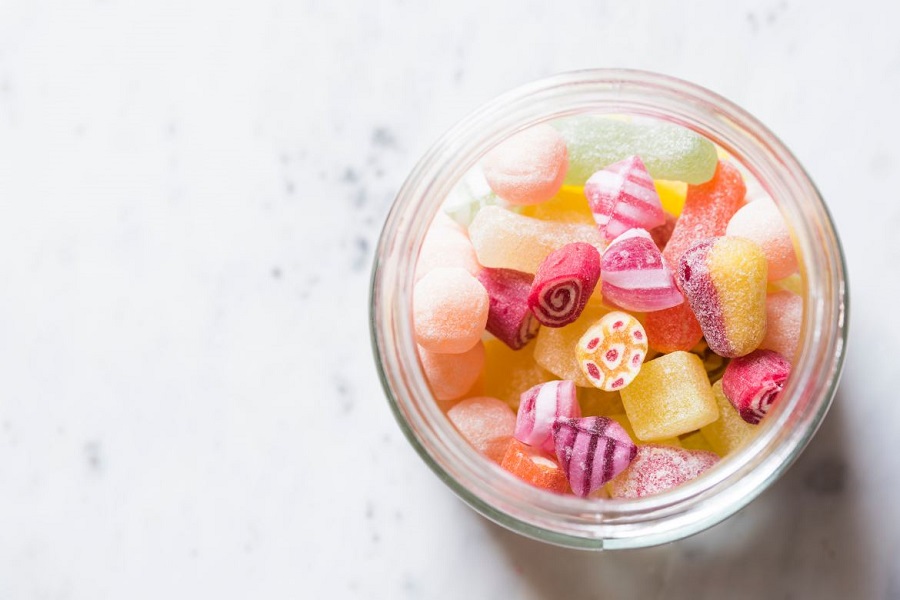While it’s said that we should “eat the rainbow” in terms of a variety of colorful foods, it’s important to be cognizant of the artificial colors that sneak their way into commonly consumed products. When artificial, bright colors are added, they can make foods appear to be more fresh and alluring, but what’s underneath the surface is really a complex chemical composition. According to the Center for Science in the Public Interest (CSPI), more than 15 million pounds of artificial food dyes go into U.S foods each year [1]. You may have heard about the risks associated with artificial food dyes in recent years, but you may be wondering, what exactly are artificial colors and dyes? And, what exactly are the risks?
Dyes are comprised of organic chemicals, many of which were originally derived from coal tar and have since been developed from petroleum, the crude oil that is used in gasoline, diesel fuel, and asphalt [1]. The FDA states that “certified colors are synthetically produced (human-made)” and used to “improve or maintain appearance” [2]. Most commonly, you may see things like “Red 40”, “Yellow 5”, and “Yellow 6” on food labels, and these three alone account for nearly 90% of all dyes used. Unfortunately, each of these dyes poses their own risks such as cancer, hypersensitivity, birth defects, and adrenal dysfunction [1].
According to the FDA, there’s been a 5-fold increase in the consumption of dye since 1955, which correlates with the rise of processed foods that make up the Standard American Diet (SAD) such as soft drinks, cereals, candy, baked goods, frozen foods, and condiments [2]. Though the FDA regulates what dyes are permitted for use in food products, there are growing concerns regarding long-term use and consumption, especially when the amount consumed, on average, is rising [1]. The FDA states that “safe means there is convincing evidence that establishes with reasonable certainty that no harm will result from the intended use of the color additive” [5]. However, several studies regarding the safety of artificial dyes have been commissioned by the dye manufacturers themselves, which poses significant limitations when evaluating the long-term health outcomes [1]. Additionally, many food dyes are tested individually, but not in combinations such as how they’re found in food.
In Europe and other countries, food dyes are either banned or carry warning labels, unlike the U.S where many are still legal. Several foods that contain dyes are highly processed already, and there’s little to no nutritional value in many of these foods. Dyes are also hidden in unsuspecting foods such as oranges, meats, yogurts, canned fruits and vegetables, and more, which is another reason why it’s important to prioritize eating foods in their most natural, whole, organic state.
There’s increasing attention being given to the consumption of artificial food dyes and the connection to hyperactivity in children as well. A 2004 study evaluating the possible connection between food coloring and hyperactivity in children found significant reductions in hyperactive behavior when artificial dyes were eliminated from the diet as well as exacerbated hyperactivity in children with the greatest food dye consumption [3]. Another study published in the Lancet in 2007 found that artificial colors and sodium benzoate preservative in children’s diets also increased hyperactivity [4]. Research has also shown that many children are affected by artificial dye amounts above 35 mg per day, although a single bowl of brightly colored cereal or macaroni and cheese can break that threshold [6]. Of course, individual sensitivity varies, but it’s important to be aware of the possible risks, and ultimately, to recognize the lack of nutritional value in artificially colored foods. According to the CSPI report, other risks associated with artificial food dyes include carcinogenic risk, hypersensitivity reactions, neurotoxicity, and genotoxicity [1].
While the use of artificial colors allows for less expensive manufacturing of foods with brighter colors, many companies are now catching on to the desire consumer’s have for more natural foods. Many products now contain natural food coloring from things like beta-carotene (the precursor to vitamin A), beet juice, paprika, or turmeric.
What to do?
- Buy organic and stick to whole foods in their most natural form.
- Ensure that you’re reading the food labels of all packaged items. Look out for specific colors or numbers on the label as well as terms like “color added,” or “tartrazine”.
- In addition to your foods, check to make sure your personal care products are also free of synthetic colors, namely toothpaste, shampoos, makeup, and anything you use topically.
- If you need a natural alternative to add your own pop of color to food, consider using things like beets, cranberry juice, carrot puree, blueberry puree, spinach puree, or even green tea powder.
SOURCES:
1. Food Dyes A Rainbow of Risks
2. Overview of Food Ingredients, Additives & Colors
3. The effects of a double blind, placebo controlled, artificial food colourings and benzoate preservative challenge on hyperactivity in a general population sample of preschool children
4. Food additives and hyperactive behaviour in 3-year-old and 8/9-year-old children in the community: a randomised, double-blinded, placebo-controlled trial
5. CFR – Code of Federal Regulations Title 21
6. Amounts of Artificial Food Dyes and Added Sugars in Foods and Sweets Commonly Consumed by Children


